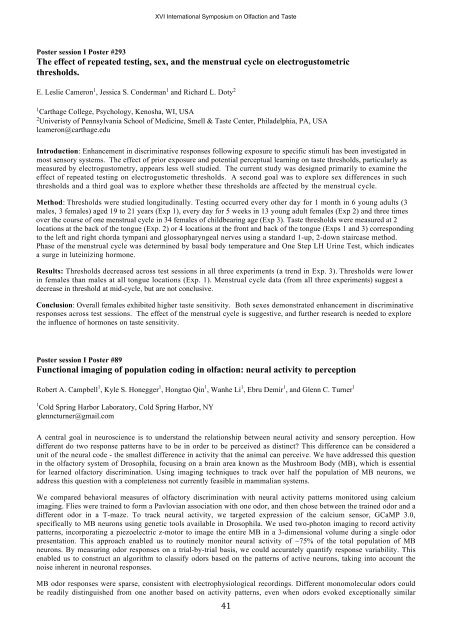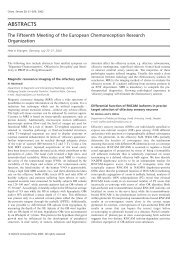XVI International Symposium on Olfaction and Taste - ecro
XVI International Symposium on Olfaction and Taste - ecro
XVI International Symposium on Olfaction and Taste - ecro
Create successful ePaper yourself
Turn your PDF publications into a flip-book with our unique Google optimized e-Paper software.
<str<strong>on</strong>g>XVI</str<strong>on</strong>g> <str<strong>on</strong>g>Internati<strong>on</strong>al</str<strong>on</strong>g> <str<strong>on</strong>g>Symposium</str<strong>on</strong>g> <strong>on</strong> Olfacti<strong>on</strong> <strong>and</strong> <strong>Taste</strong><br />
Poster sessi<strong>on</strong> I Poster #293<br />
The effect of repeated testing, sex, <strong>and</strong> the menstrual cycle <strong>on</strong> electrogustometric<br />
thresholds.<br />
E. Leslie Camer<strong>on</strong> 1 , Jessica S. C<strong>on</strong>derman 1 <strong>and</strong> Richard L. Doty 2<br />
1 Carthage College, Psychology, Kenosha, WI, USA<br />
2 Univeristy of Pennsylvania School of Medicine, Smell & <strong>Taste</strong> Center, Philadelphia, PA, USA<br />
lcamer<strong>on</strong>@carthage.edu<br />
Introducti<strong>on</strong>: Enhancement in discriminative resp<strong>on</strong>ses following exposure to specific stimuli has been investigated in<br />
most sensory systems. The effect of prior exposure <strong>and</strong> potential perceptual learning <strong>on</strong> taste thresholds, particularly as<br />
measured by electrogustometry, appears less well studied. The current study was designed primarily to examine the<br />
effect of repeated testing <strong>on</strong> electrogustometic thresholds. A sec<strong>on</strong>d goal was to explore sex differences in such<br />
thresholds <strong>and</strong> a third goal was to explore whether these thresholds are affected by the menstrual cycle.<br />
Method: Thresholds were studied l<strong>on</strong>gitudinally. Testing occurred every other day for 1 m<strong>on</strong>th in 6 young adults (3<br />
males, 3 females) aged 19 to 21 years (Exp 1), every day for 5 weeks in 13 young adult females (Exp 2) <strong>and</strong> three times<br />
over the course of <strong>on</strong>e menstrual cycle in 34 females of childbearing age (Exp 3). <strong>Taste</strong> thresholds were measured at 2<br />
locati<strong>on</strong>s at the back of the t<strong>on</strong>gue (Exp. 2) or 4 locati<strong>on</strong>s at the fr<strong>on</strong>t <strong>and</strong> back of the t<strong>on</strong>gue (Exps 1 <strong>and</strong> 3) corresp<strong>on</strong>ding<br />
to the left <strong>and</strong> right chorda tympani <strong>and</strong> glossopharyngeal nerves using a st<strong>and</strong>ard 1-up, 2-down staircase method.<br />
Phase of the menstrual cycle was determined by basal body temperature <strong>and</strong> One Step LH Urine Test, which indicates<br />
a surge in luteinizing horm<strong>on</strong>e.<br />
Results: Thresholds decreased across test sessi<strong>on</strong>s in all three experiments (a trend in Exp. 3). Thresholds were lower<br />
in females than males at all t<strong>on</strong>gue locati<strong>on</strong>s (Exp. 1). Menstrual cycle data (from all three experiments) suggest a<br />
decrease in threshold at mid-cycle, but are not c<strong>on</strong>clusive.<br />
C<strong>on</strong>clusi<strong>on</strong>: Overall females exhibited higher taste sensitivity. Both sexes dem<strong>on</strong>strated enhancement in discriminative<br />
resp<strong>on</strong>ses across test sessi<strong>on</strong>s. The effect of the menstrual cycle is suggestive, <strong>and</strong> further research is needed to explore<br />
the influence of horm<strong>on</strong>es <strong>on</strong> taste sensitivity.<br />
Poster sessi<strong>on</strong> I Poster #89<br />
Functi<strong>on</strong>al imaging of populati<strong>on</strong> coding in olfacti<strong>on</strong>: neural activity to percepti<strong>on</strong><br />
Robert A. Campbell 1 , Kyle S. H<strong>on</strong>egger 1 , H<strong>on</strong>gtao Qin 1 , Wanhe Li 1 , Ebru Demir 1 , <strong>and</strong> Glenn C. Turner 1<br />
1<br />
Cold Spring Harbor Laboratory, Cold Spring Harbor, NY<br />
glenncturner@gmail.com<br />
A central goal in neuroscience is to underst<strong>and</strong> the relati<strong>on</strong>ship between neural activity <strong>and</strong> sensory percepti<strong>on</strong>. How<br />
different do two resp<strong>on</strong>se patterns have to be in order to be perceived as distinct? This difference can be c<strong>on</strong>sidered a<br />
unit of the neural code - the smallest difference in activity that the animal can perceive. We have addressed this questi<strong>on</strong><br />
in the olfactory system of Drosophila, focusing <strong>on</strong> a brain area known as the Mushroom Body (MB), which is essential<br />
for learned olfactory discriminati<strong>on</strong>. Using imaging techniques to track over half the populati<strong>on</strong> of MB neur<strong>on</strong>s, we<br />
address this questi<strong>on</strong> with a completeness not currently feasible in mammalian systems.<br />
We compared behavioral measures of olfactory discriminati<strong>on</strong> with neural activity patterns m<strong>on</strong>itored using calcium<br />
imaging. Flies were trained to form a Pavlovian associati<strong>on</strong> with <strong>on</strong>e odor, <strong>and</strong> then chose between the trained odor <strong>and</strong> a<br />
different odor in a T-maze. To track neural activity, we targeted expressi<strong>on</strong> of the calcium sensor, GCaMP 3.0,<br />
specifically to MB neur<strong>on</strong>s using genetic tools available in Drosophila. We used two-phot<strong>on</strong> imaging to record activity<br />
patterns, incorporating a piezoelectric z-motor to image the entire MB in a 3-dimensi<strong>on</strong>al volume during a single odor<br />
presentati<strong>on</strong>. This approach enabled us to routinely m<strong>on</strong>itor neural activity of ~75% of the total populati<strong>on</strong> of MB<br />
neur<strong>on</strong>s. By measuring odor resp<strong>on</strong>ses <strong>on</strong> a trial-by-trial basis, we could accurately quantify resp<strong>on</strong>se variability. This<br />
enabled us to c<strong>on</strong>struct an algorithm to classify odors based <strong>on</strong> the patterns of active neur<strong>on</strong>s, taking into account the<br />
noise inherent in neur<strong>on</strong>al resp<strong>on</strong>ses.<br />
MB odor resp<strong>on</strong>ses were sparse, c<strong>on</strong>sistent with electrophysiological recordings. Different m<strong>on</strong>omolecular odors could<br />
be readily distinguished from <strong>on</strong>e another based <strong>on</strong> activity patterns, even when odors evoked excepti<strong>on</strong>ally similar<br />
41



